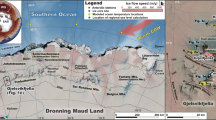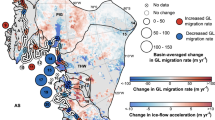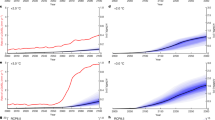Abstract
Predictions for sea-level rise this century due to melt from Antarctica range from zero to more than one metre. The highest predictions are driven by the controversial marine ice-cliff instability (MICI) hypothesis, which assumes that coastal ice cliffs can rapidly collapse after ice shelves disintegrate, as a result of surface and sub-shelf melting caused by global warming. But MICI has not been observed in the modern era and it remains unclear whether it is required to reproduce sea-level variations in the geological past. Here we quantify ice-sheet modelling uncertainties for the original MICI study and show that the probability distributions are skewed towards lower values (under very high greenhouse gas concentrations, the most likely value is 45 centimetres). However, MICI is not required to reproduce sea-level changes due to Antarctic ice loss in the mid-Pliocene epoch, the last interglacial period or 1992–2017; without it we find that the projections agree with previous studies (all 95th percentiles are less than 43 centimetres). We conclude that previous interpretations of these MICI projections over-estimate sea-level rise this century; because the MICI hypothesis is not well constrained, confidence in projections with MICI would require a greater range of observationally constrained models of ice-shelf vulnerability and ice-cliff collapse.
This is a preview of subscription content, access via your institution
Access options
Access Nature and 54 other Nature Portfolio journals
Get Nature+, our best-value online-access subscription
$29.99 / 30 days
cancel any time
Subscribe to this journal
Receive 51 print issues and online access
$199.00 per year
only $3.90 per issue
Buy this article
- Purchase on Springer Link
- Instant access to full article PDF
Prices may be subject to local taxes which are calculated during checkout




Similar content being viewed by others
Data availability
All projections from this study are available from the corresponding author on request. Simulations of the last interglacial, Pliocene and 1992–2017 and 2000–2100 sea-level contributions for all DP16 ensemble members are available on Code Ocean (https://doi.org/10.24433/CO.4ebd8cda-35c0-4d8f-9b7c-d1b064109437). Simulations at 2500 for the subset of the DP16 ensemble that pass their calibration are available in the supplementary information of DP16.
References
IPCC. Climate Change 2013: The Physical Science Basis. Working Group I Contribution to the IPCC Fifth Assessment Report (Cambridge Univ. Press, Cambridge, 2013).
Little, C. M., Oppenheimer, M. & Urban, N. M. Upper bounds on twenty-first-century Antarctic ice loss assessed using a probabilistic framework. Nat. Clim. Chang. 3, 654–659 (2013).
Levermann, A. et al. Projecting Antarctic ice discharge using response functions from SeaRISE ice-sheet models. Earth Syst. Dynam. 5, 271–293 (2014).
Ritz, C. et al. Potential sea-level rise from Antarctic ice-sheet instability constrained by observations. Nature 528, 115–118 (2015).
Ruckert, K. L. et al. Assessing the impact of retreat mechanisms in a simple Antarctic Ice Sheet model using Bayesian calibration. PLoS One 12, e0170052 (2017).
DeConto, R. M. & Pollard, D. Contribution of Antarctica to past and future sea-level rise. Nature 531, 591–597 (2016).
Pollard, D., DeConto, R. M. & Alley, R. B. Potential Antarctic Ice Sheet retreat driven by hydrofracturing and ice cliff failure. Earth Planet. Sci. Lett. 412, 112–121 (2015).
Hellmer, H. H., Kauker, F., Timmermann, R., Determann, J. & Rae, J. Twenty-first-century warming of a large Antarctic ice-shelf cavity by a redirected coastal current. Nature 485, 225–228 (2012).
Kuipers Munneke, P., Ligtenberg, S. R. M., van den Broeke, M. R. & Vaughan, D. G. Firn air depletion as a precursor of Antarctic ice-shelf collapse. J. Glaciol. 60, 205–214 (2014).
Trusel, L. D. et al. Divergent trajectories of Antarctic surface melt under two twenty-first-century climate scenarios. Nat. Geosci. 8, 927–932 (2015).
Vaughan, D. G. West Antarctic Ice Sheet collapse – the fall and rise of a paradigm. Clim. Change 91, 65–79 (2008).
Schoof, C. Ice sheet grounding line dynamics: steady states, stability, and hysteresis. J. Geophys. Res. 112, F03S28 (2007).
Rignot, E., Mouginot, J., Morlighem, M., Seroussi, H. & Scheuchl, B. Widespread, rapid grounding line retreat of Pine Island, Thwaites, Smith, and Kohler glaciers, West Antarctica, from 1992 to 2011. Geophys. Res. Lett. 41, 3502–3509 (2014).
Favier, L. et al. Retreat of Pine Island Glacier controlled by marine ice-sheet instability. Nat. Clim. Chang. 4, 117–121 (2014).
Joughin, I., Smith, B. E. & Medley, B. Marine ice sheet collapse potentially under way for the Thwaites Glacier basin, West Antarctica. Science 344, 735–738 (2014).
Waugh, D. W., Primeau, F., DeVries, T. & Holzer, M. Recent changes in the ventilation of the southern oceans. Science 339, 568–570 (2013).
Previdi, M. & Polvani, L. M. Climate system response to stratospheric ozone depletion and recovery. Q. J. R. Meteorol. Soc. 140, 2401–2419 (2014).
Bassis, J. N. & Walker, C. C. Upper and lower limits on the stability of calving glaciers from the yield strength envelope of ice. Proc. R. Soc. Lond. A. 468, 913–931 (2012).
Sweeney, J., Salter-Townshend, M., Edwards, T., Buck, C. E. & Parnell, A. C. Statistical challenges in estimating past climate changes. Wiley Interdiscip. Rev. Comput. Stat. 10, e1437 (2018).
Gasson, E., DeConto, R. M. & Pollard, D. Modeling the oxygen isotope composition of the Antarctic ice sheet and its significance to Pliocene sea-level. Geology 44, 827–830 (2016).
Williamson, D., Blaker, A., Hampton, C. & Salter, J. Identifying and removing structural biases in climate models with history matching. Clim. Dyn. 45, 1299–1324 (2015).
McNeall, D. et al. The impact of structural error on parameter constraint in a climate model. Earth Syst. Dynam. 7, 917–935 (2016).
Williamson, D., Blaker, A. T. & Sinha, B. Tuning without over-tuning: parametric uncertainty quantification for the NEMO ocean model. Geosci. Model Dev. 10, 1789–1816 (2017).
Gladstone, R. M. et al. Calibrated prediction of Pine Island Glacier retreat during the 21st and 22nd centuries with a coupled flowline model. Earth Planet. Sci. Lett. 333–334, 191–199 (2012).
The IMBIE team. Mass balance of the Antarctic Ice Sheet from 1992 to 2017. Nature 558, 219–222 (2018).
Golledge, N. R. et al. Global environmental consequences of twenty-first-century ice-sheet melt. Nature 566, https://doi.org/10.1038/s41586-019-0889-9 (2018).
Le Bars, D., Drijfhout, S. & de Vries, H. A high-end sea-level rise probabilistic projection including rapid Antarctic ice sheet mass loss. Environ. Res. Lett. 12, 044013 (2017).
Golledge, N. R. et al. The multi-millennial Antarctic commitment to future sea-level rise. Nature 526, 421–425 (2015).
Cornford, S. L. et al. Century-scale simulations of the response of the West Antarctic Ice Sheet to a warming climate. Cryosphere 9, 1579–1600 (2015).
Wise, M. G., Dowdeswell, J. A., Jakobsson, M. & Larter, R. D. Evidence of marine ice-cliff instability in PineIsland Bay from iceberg-keel plough marks. Nature 550, 506–510 (2017).
Bell, R. E. et al. Antarctic ice shelf potentially stabilized by export of meltwater in surface river. Nature 544, 344–348 (2017).
Kingslake, J., Ely, J. C., Das, I. & Bell, R. E. Widespread movement of meltwater onto and across Antarctic ice shelves. Nature 544, 349–352 (2017).
Gourmelen, N. et al. Channelized melting drives thinning under a rapidly melting Antarctic ice shelf. Geophys. Res. Lett. 44, 9796–9804 (2017).
Pattyn, F., Favier, L., Sun, S. & Durand, G. Progress in numerical modeling of Antarctic ice-sheet dynamics. Curr. Clim. Change Rep. 3, 174–184 (2017).
Golledge, N. et al. Antarctic climate and ice-sheet configuration during the early Pliocene interglacial at 4.23 Ma. Clim. Past 13, 959–975 (2017).
Pukelsheim, F. The three sigma rule. Am. Stat. 48, 88–91 (1994).
Miller, K. G. et al. High tide of the warm Pliocene: implications of global sea-level for Antarctic deglaciation. Geology 40, 407–410 (2012).
Raymo, M. E. et al. The accuracy of mid-Pliocene δ18O-based ice volume and sea level reconstructions. Earth Sci. Rev. 177, 291–302 (2018).
Kopp, R. E., Simons, F. J., Mitrovica, J. X., Maloof, A. C. & Oppenheimer, M. A probabilistic assessment of sea-level variations within the last interglacial stage. Geophys. J. Int. 193, 711–716 (2013).
Düsterhus, A., Tamisiea, M. E. & Jevrejeva, S. Estimating the sea-level highstand during the last interglacial: a probabilistic massive ensemble approach. Geophys. J. Int. 206, 900–920 (2016).
Austermann, J., Mitrovica, J. X., Huybers, P. & Rovere, A. Detection of a dynamic topography signal in last interglacial sea-level records. Sci. Adv. 3, e1700457 (2017).
Nias, I., Cornford, S. L. & Payne, A. J. Contrasting model sensitivity of the Amundsen Sea embayment ice streams. J. Glaciol. 62, 552–562 (2016).
Holden, P. B., Edwards, N. R., Oliver, K. I. C., Lenton, T. M. & Wilkinson, R. D. A probabilistic calibration of climate sensitivity and terrestrial carbon change in GENIE-1. Clim. Dyn. 35, 785–806 (2010).
Edwards, N. R., Cameron, D. & Rougier, J. Precalibrating an intermediate complexity climate model. Clim. Dyn. 37, 1469–1482 (2011).
Nowicki, S. M. J. et al. Ice Sheet Model Intercomparison Project (ISMIP6) contribution to CMIP6. Geosci. Model Dev. 9, 4521–4545 (2016).
O’Hagan, A. Bayesian analysis of computer code outputs: a tutorial. Reliab. Eng. Syst. Saf. 91, 1290–1300 (2006).
Sweet, W. V. et al. Global and Regional Sea-Level Rise Scenarios for the United States. Report No. NOS CO-OPS 083 (NOAA, 2017).
Williamson, D. et al. History matching for exploring and reducing climate model parameter space using observations and a large perturbed physics ensemble. Clim. Dyn. 41, 1703–1729 (2013).
Dutton, A. et al. Sea-level rise due to polar ice-sheet mass loss during past warm periods. Science 349, aaa4019 (2015).
Vernon, I., Goldstein, M. & Bower, R. G. Galaxy formation: a Bayesian uncertainty analysis. Bayesian Anal. 5, 619–669 (2010).
Acknowledgements
T.L.E., N.R.E. and P.B.H. were supported by EPSRC Research on Changes of Variability and Environmental Risk (ReCoVER: EP/M008495/1) under the Quantifying Uncertainty in Antarctic Ice Sheet Instability (QUAntIS) project (RFFLP 006). T.L.E. was also supported by the EPSRC-funded Past Earth Network (EP/M008363/1) and the Université Joseph Fourier–Grenoble International visitor fund ‘Campagne INVITES’. N.R.G. is supported by contract VUW1501 from the Royal Society Te Aparangi. I.J.N. was supported by the NERC iSTAR-C project Dynamical control on the response of Pine Island Glacier (NE/J005738/1) and now by the NASA Sea Level Change programme. A.W. is supported by the Open University Faculty of Science, Technology, Engineering and Mathematics. We thank R. DeConto for running additional simulations necessary for the analysis, suggestions and discussions, and K. Ruckert and A. Levermann for providing data. We thank the statisticians who attended the Past Earth Network events ‘Assessing Palaeoclimate Uncertainty’ (held jointly with the Environmental Statistics Section of the Royal Statistics Society, Cambridge, August 2016), ‘Emulators workshop’ (Leeds, June 2017) and writing retreat (Callow Hall, August 2017) for advice, particularly I. Vernon, P. Challenor and J. Rougier. We thank D. Le Bars, D. McNeall, D. Demeritt and the King’s Geography Hazards, Risk and Regulation reading group (G. Adamson, F. Liu, A. Razli, L. Ball and A. Heilbron) for comments on the manuscript. We also thank K.-K. Shiu and D. Campbell for supporting T.L.E. in this work.
Author information
Authors and Affiliations
Contributions
T.L.E. conceived the idea, carried out the analysis, produced the figures and wrote the manuscript. A.W. and P.B.H. performed preliminary analyses. A.J.P., A.W., C.R., G.D., I.J.N., M.A.B. and N.R.G. contributed ideas on glaciological and oceanic aspects; A.W., N.R.E. and P.B.H. contributed ideas on statistical aspects. All authors contributed to writing the manuscript.
Corresponding author
Ethics declarations
Conflict of interest
The authors declare no competing interests.
Additional information
Publisher’s note: Springer Nature remains neutral with regard to jurisdictional claims in published maps and institutional affiliations.
Extended data figures and tables
Extended Data Fig. 1 Sensitivity of DP16 RCP8.5 projections to the lower bound of the Pliocene data.
a, b, Bias-uncorrected (a) and bias-corrected (b) DP16 projections6 for Antarctic sea-level contribution by 2100 under RCP8.5 as a function of the lower bound of the Pliocene data range. The solid red line and pink shading show the mean ± 1 s.d.; the dotted lines indicate ±2 s.d. c, Sensitivity of our emulated projections for RCP8.5 at 2100 with MICI: lines show 5th, 25th, 50th, 75th and 95th percentiles; asterisks indicate the mode.
Extended Data Fig. 2 DP16 RCP8.5 projection distributions.
a–d, DP16 ensemble projections6 for Antarctic sea-level contribution by 2100 under RCP8.5 for their four variants—low-Pliocene bias-uncorrected (a), low-Pliocene bias-corrected (b), high-Pliocene bias-uncorrected (c) and high-Pliocene bias-corrected (d)—showing the full 64-member ensemble (grey) and the subset selected by calibrating with Pliocene and last interglacial sea-level reconstructions (red). The solid red lines and pink shading show the mean ± 1 s.d.; the horizontal black lines indicate the ≥68% probability interval (see main text and Methods for more details).
Extended Data Fig. 3 Relationships between RCP8.5 projections at 2100 and past sea-level changes.
a–c, Sea-level contribution at 2100 under RCP8.5 versus sea-level contribution during the Pliocene (a), last interglacial (b) and from 1992 to 2017 (c), for the emulator (small grey dots) and DP16 simulator (large open circles; ref. 6 and R. DeConto, personal communication), with ocean bias correction off (blue) and on (red). Grey shading indicates the DP16 palaeodata range (a, b) or observational mean ± 3 s.d.25 (c); the dashed lines additionally include model error.
Extended Data Fig. 4 Relationship between past and future sea-level changes with and without MICI.
a, b, Simulator ensemble (large circles; ref. 6 and R. DeConto, personal communication) and emulated ensembles (small circles) with (a) and without (b) MICI, showing Pliocene versus last interglacial sea-level changes, with the colour scale indicating the sea-level equivalent (SLE) contribution at 2100 under RCP8.5. Large emulator points and filled simulator points are those that pass the 1992–2017 calibration25. The shaded rectangle indicates the bounds of the DP16 low-Pliocene and last interglacial palaeodata constraints; the dashed rectangle shows constraints in this study (which include model error).
Extended Data Fig. 5 Sensitivity of RCP8.5 projections to MICI and calibration choices.
Projections for RCP8.5 at 2100 are shown with and without MICI, for different combinations of calibration eras (‘palaeo’, Pliocene and last interglacial; present, 1992–2017) and model discrepancy (with, without or double). Box and whiskers show the 5th, 25th, 50th, 75th and 95th percentiles; asterisks show the mode. Numbers alongside each plot indicate the median, the 5%–95% probability interval and the mode (in parentheses and asterisked).
Extended Data Fig. 6 Emulator validation.
Left column, emulator prediction versus simulation for each ensemble member, with the emulator fitted to the other ensemble members, for each of the outputs used for building and validating emulator structure: RCP8.5, RCP4.5 and RCP2.6 sea-level contribution at 2100; 1992–2017 contribution; last interglacial; and Pliocene. Vertical error bars show 95% credibility intervals. Right column, difference between emulator predictions and simulations, standardized by emulator error, for the same six outputs. Values falling mostly between ±2 indicate that the emulator has adequate uncertainty estimates. Simulation data from ref. 6 and R. DeConto (personal communication).
Extended Data Fig. 7 Sensitivity of RCP8.5 projections to model parameters.
a–c, Sea-level contribution at 2100 under RCP8.5 versus VCLIF (a), CREVLIQ (b) and OCFAC (c) parameters for the emulator (small grey dots with error bars) and simulator (large open circles; blue, bias-uncorrected; red, bias-corrected). Simulation data from ref. 6 and R. DeConto (personal communication).
Rights and permissions
About this article
Cite this article
Edwards, T.L., Brandon, M.A., Durand, G. et al. Revisiting Antarctic ice loss due to marine ice-cliff instability. Nature 566, 58–64 (2019). https://doi.org/10.1038/s41586-019-0901-4
Received:
Accepted:
Published:
Issue Date:
DOI: https://doi.org/10.1038/s41586-019-0901-4
This article is cited by
-
East Antarctic warming forced by ice loss during the Last Interglacial
Nature Communications (2024)
-
Progressive unanchoring of Antarctic ice shelves since 1973
Nature (2024)
-
An ancient river landscape preserved beneath the East Antarctic Ice Sheet
Nature Communications (2023)
-
Future sea-level projections with a coupled atmosphere-ocean-ice-sheet model
Nature Communications (2023)
-
Chronic flooding events due to sea-level rise in French Guiana
Scientific Reports (2023)
Comments
By submitting a comment you agree to abide by our Terms and Community Guidelines. If you find something abusive or that does not comply with our terms or guidelines please flag it as inappropriate.



